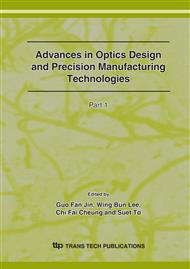p.1048
p.1054
p.1061
p.1066
p.1072
p.1077
p.1083
p.1089
p.1095
High Brightness White Organic Light Emitting Devices Employing Phosphorescent Iridium Complex as RGB Dopants
Abstract:
An efficient phosphorescent white organic light-emitting diode (WOLED) was realized by using a bright blue-emitting layer, iridium (III) bis [(4, 6-di-fluoropheny)-pyridinato-N, C2’] picolinate doped 4.4’-bis (9-carbazolyl)-2, 2’-dimethyl-biphenyl, together with tris (2- Phenylpyridine) iridium and bis (1-phenyl-isoquinoline) acetylacetonate iridium (III) were codoped into 4,4’-N,N’-dicarbazole-biphenyl layer to provide blue, green, and red emission for color mixing. The device emission color was controlled by varying dopant concentrations and the thickness of blue and green-red layers as well as tuning the thickness of exciton-blocking layer. The maximum luminance and power efficiency of the WOLED were 37100cd/m2 at 17 V and 7.37lm/W at 5V, respectively. The Commission Internationale de 1’Eclairage (CIE) chromaticity coordinate changes from (0.41, 0.42) to (0.37, 0.39) when the luminance rangeed from 1000cd/m2 to 30000cd/m2.
Info:
Periodical:
Pages:
1072-1076
Citation:
Online since:
December 2007
Authors:
Price:
Сopyright:
© 2008 Trans Tech Publications Ltd. All Rights Reserved
Share:
Citation:


